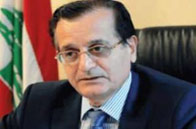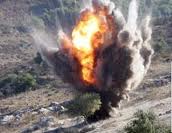
26 years on, Sabra and Chatila still bear scars ~ Site of wartime massacre has yet to recover

By Nicholas Kimbrell
Source: Daily Star, 16-9-2008
BEIRUT: Twenty-six years ago Monday the massacre in Sabra and Chatila began. Three-and-a-half days later, hundreds of Palestinian and Lebanese men, women and children had been murdered by Christian militiamen who worked by day and under "Israeli" flares at night. Hundreds more from the Sabra and Chatila camps and the surrounding neighborhoods in Beirut's southern suburbs had gone missing.
Following the assassination of President-elect Bachir Gemayel, "Israeli" troops moved into West Beirut in violation of the pact US envoy special Philip Habib had hammered out between the "Israeli" Army, the Lebanese government and the Palestine Liberation Organization (PLO). The agreement had facilitated the evacuation of 11,000 PLO fighters from Lebanon, and the US government had promised to protect the remaining Palestinian population.
After reported shelling and sniper fire, the "Israeli" Army - under the command of Defense (War) Minister Ariel Sharon and army Chief of Staff Rafael Eitan - surrounded Sabra and Chatila on September 15. The next day, Christian militiamen, many of them "Israeli"-trained and supplied, entered the camps. What ensued was a campaign of butchery, rape and murder.
The final death toll remains unknown - some estimates are in the low hundreds, while others are in the thousands. But the piles of bodies with slit throats and execution-style bullet wounds were reported widely by the press.
Following a popular outcry in "Israel" and an investigative commission led by Supreme Court President Yitzak Kahan, Sharon was forced to resign as defense minister.
The Sabra and Chatila massacre was perhaps the darkest chapter in a campaign of reciprocal violence between Lebanese Christian militias and Lebanon's Palestinian refugee population during the 1975-1990 Civil War.
Today, despite modest revitalizations, Sabra and Chatila still bear the scars of serial bombing raids and the massacre. Amid concrete apartment blocks, street-side vendors and remaining rubble, there is an open field memorial for the dead.
The area remains heavily populated and some Lebanese have even moved into the camps because of low rental prices.
But a full-scale renewal has yet to take place.
Two years ago, the United Nations Works and Relief Agency (UNRWA), in partnership with the Palestinian-Lebanese Dialogue Committee (PLDC) and other groups, held a donors' conference to raise money for all of the Palestinian camps in Lebanon. Around $20 million was raised for the Camp Improvement Initiative, nearly $30 million short of the targeted amount.
Ambassador Khalil Makkawi, head of the PLDC, told The Daily Star that some of this money has been used to improve Sabra and Chatila.
"The job is so big, dealing with issues that date back 60 years ... [and] we just started three years ago," Makkawi said. "We need time, energy and resources."
Hoda al-Turk of UNWRA also confirmed that some of the Camp Improvement Initiative funds have been used in Sabra and Chatila.
"We have started on infrastructure [improvement] in Sabra, Chatila, Bourj al-Barajneh and Mar Elias," she said.
UNRWA is also heading up the emergency assistance and recovery efforts in the Nahr al-Bared camp outside Tripoli, which was battered in heavy fighting last year.
Though the scars, human and structural, remain in Sabra and Chatila, Makkawi sounded a positive note. "For the first time, the government has given its [support] to improving the conditions of the camps," he said.
Numerous commemorations have been planned from September 15-20 in Sabra and Chatila to mark the 26th anniversary of the massacre.
Source: Daily Star, 16-9-2008
BEIRUT: Twenty-six years ago Monday the massacre in Sabra and Chatila began. Three-and-a-half days later, hundreds of Palestinian and Lebanese men, women and children had been murdered by Christian militiamen who worked by day and under "Israeli" flares at night. Hundreds more from the Sabra and Chatila camps and the surrounding neighborhoods in Beirut's southern suburbs had gone missing.
Following the assassination of President-elect Bachir Gemayel, "Israeli" troops moved into West Beirut in violation of the pact US envoy special Philip Habib had hammered out between the "Israeli" Army, the Lebanese government and the Palestine Liberation Organization (PLO). The agreement had facilitated the evacuation of 11,000 PLO fighters from Lebanon, and the US government had promised to protect the remaining Palestinian population.
After reported shelling and sniper fire, the "Israeli" Army - under the command of Defense (War) Minister Ariel Sharon and army Chief of Staff Rafael Eitan - surrounded Sabra and Chatila on September 15. The next day, Christian militiamen, many of them "Israeli"-trained and supplied, entered the camps. What ensued was a campaign of butchery, rape and murder.
The final death toll remains unknown - some estimates are in the low hundreds, while others are in the thousands. But the piles of bodies with slit throats and execution-style bullet wounds were reported widely by the press.
Following a popular outcry in "Israel" and an investigative commission led by Supreme Court President Yitzak Kahan, Sharon was forced to resign as defense minister.
The Sabra and Chatila massacre was perhaps the darkest chapter in a campaign of reciprocal violence between Lebanese Christian militias and Lebanon's Palestinian refugee population during the 1975-1990 Civil War.
Today, despite modest revitalizations, Sabra and Chatila still bear the scars of serial bombing raids and the massacre. Amid concrete apartment blocks, street-side vendors and remaining rubble, there is an open field memorial for the dead.
The area remains heavily populated and some Lebanese have even moved into the camps because of low rental prices.
But a full-scale renewal has yet to take place.
Two years ago, the United Nations Works and Relief Agency (UNRWA), in partnership with the Palestinian-Lebanese Dialogue Committee (PLDC) and other groups, held a donors' conference to raise money for all of the Palestinian camps in Lebanon. Around $20 million was raised for the Camp Improvement Initiative, nearly $30 million short of the targeted amount.
Ambassador Khalil Makkawi, head of the PLDC, told The Daily Star that some of this money has been used to improve Sabra and Chatila.
"The job is so big, dealing with issues that date back 60 years ... [and] we just started three years ago," Makkawi said. "We need time, energy and resources."
Hoda al-Turk of UNWRA also confirmed that some of the Camp Improvement Initiative funds have been used in Sabra and Chatila.
"We have started on infrastructure [improvement] in Sabra, Chatila, Bourj al-Barajneh and Mar Elias," she said.
UNRWA is also heading up the emergency assistance and recovery efforts in the Nahr al-Bared camp outside Tripoli, which was battered in heavy fighting last year.
Though the scars, human and structural, remain in Sabra and Chatila, Makkawi sounded a positive note. "For the first time, the government has given its [support] to improving the conditions of the camps," he said.
Numerous commemorations have been planned from September 15-20 in Sabra and Chatila to mark the 26th anniversary of the massacre.


